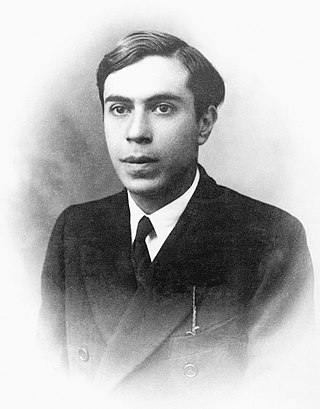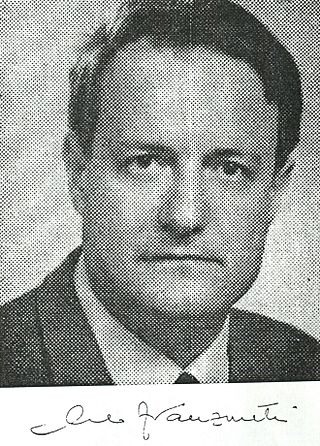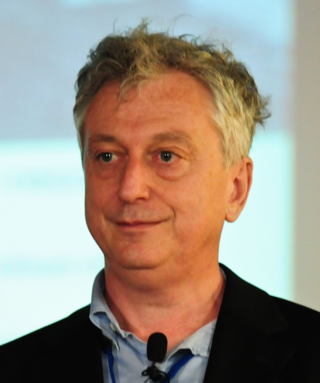
Ugo Amaldi; born 26 August 1934, is an Italian physicist, mainly working in the fields of particle and medical physics. [1] [2]

Ugo Amaldi; born 26 August 1934, is an Italian physicist, mainly working in the fields of particle and medical physics. [1] [2]
Amaldi studied at the University of Rome where he graduated in physics in 1957. [3]
He started his career as a researcher at the Italian National Institute of Health (ISS), where he later became research director. Shortly after he took up the appointment, Amaldi led an ISS group of physicists carrying out nuclear physics experiments at the laboratory CERN in Geneva. [4]
As of 1973 he became CERN staff member. [5] From 1980 to 1993 he served as spokesman for the DELPHI Collaboration, which operated an experiment at the Large Electron-Positron Collider (LEP). Amaldi retired officially from CERN in 1999, when he reached the fixed retirement age of 65.
Between 1990 and 2006 Amaldi was physics professor at the universities in Florence and Milan.
Amaldi is founder and president of the TERA foundation—registered in Italy—since its creation in 1992. [6] [5] The foundation works within the field of tumour therapy with hadronic radiations. The foundation has played a central role in the design of the Italian National Centre for Oncological Hadrontherapy (CNAO). [7] In 2016 the foundation engaged in a proposal to construct a facility for charged particle cancer therapy for the South Eastern European countries. [8]
In the early 1970s, Amaldi co-discovered the proton-proton rising cross-section through experiments carried out at the CERN accelerator Intersecting Storage Rings. [9] In 1975 he founded with K. Winter the CHARM Collaboration, which performed many fundamental experiments on neutrino scattering. In 1991, using the first LEP data he gave a widely recognized contribution to the understanding of the unification of the electroweak and strong forces.
Amaldi co-authored in 1984, with his father and mother, an updated version of a well known physics textbook in three volumes for Italian high schools. [10] [11] The first edition, Corso di fisica by his parents only, was published in 1952 and was a rework of the original book authored by Enrico Fermi. After all these years, the book has continued to be published in new editions for years, in 2020 under the title Il nuovo Amaldi. [12]
![]() Commander (Commendatore Ordine) of the Order of Merit of the Italian Republic (2008). [13]
Commander (Commendatore Ordine) of the Order of Merit of the Italian Republic (2008). [13]
Amaldi holds honorary doctorates from University of Uppsala (1993), [14] University of Lyon (1997), [15] University of Valencia (1999) [16] and University of Helsinki (2000). [17] He is a Fellow of the European Physical Society, a Distinguished Affiliated Professor at Technical University of Munich, [18] member of the Accademia dei Lincei, and was awarded the inaugural Bruno Pontecorvo Prize by JINR. [19] [20]
Amaldi resides in Cologny in the canton of Geneva. He is the son of the first CERN secretary general Edoardo Amaldi and physicist Ginestra Giovene Amaldi, and the grandson of mathematician Ugo Amaldi. [2]

The European Organization for Nuclear Research, known as CERN, is an intergovernmental organization that operates the largest particle physics laboratory in the world. Established in 1954, it is based in Meyrin, western suburb of Geneva, on the France–Switzerland border. It comprises 24 member states. Israel, admitted in 2013, is the only non-European full member. CERN is an official United Nations General Assembly observer.

Ettore Majorana was an Italian theoretical physicist who worked on neutrino masses. On 25 March 1938, he disappeared under mysterious circumstances after purchasing a ticket to travel by ship from Naples to Palermo.

The Large Electron–Positron Collider (LEP) was one of the largest particle accelerators ever constructed. It was built at CERN, a multi-national centre for research in nuclear and particle physics near Geneva, Switzerland.

Gargamelle was a heavy liquid bubble chamber detector in operation at CERN between 1970 and 1979. It was designed to detect neutrinos and antineutrinos, which were produced with a beam from the Proton Synchrotron (PS) between 1970 and 1976, before the detector was moved to the Super Proton Synchrotron (SPS). In 1979 an irreparable crack was discovered in the bubble chamber, and the detector was decommissioned. It is currently part of the "Microcosm" exhibition at CERN, open to the public.

High-energy nuclear physics studies the behavior of nuclear matter in energy regimes typical of high-energy physics. The primary focus of this field is the study of heavy-ion collisions, as compared to lighter atoms in other particle accelerators. At sufficient collision energies, these types of collisions are theorized to produce the quark–gluon plasma. In peripheral nuclear collisions at high energies one expects to obtain information on the electromagnetic production of leptons and mesons that are not accessible in electron–positron colliders due to their much smaller luminosities.

The ISR was a particle accelerator at CERN. It was the world's first hadron collider, and ran from 1971 to 1984, with a maximum center of mass energy of 62 GeV. From its initial startup, the collider itself had the capability to produce particles like the J/ψ and the upsilon, as well as observable jet structure; however, the particle detector experiments were not configured to observe events with large momentum transverse to the beamline, leaving these discoveries to be made at other experiments in the mid-1970s. Nevertheless, the construction of the ISR involved many advances in accelerator physics, including the first use of stochastic cooling, and it held the record for luminosity at a hadron collider until surpassed by the Tevatron in 2004.

Edoardo Amaldi was an Italian physicist. He coined the term "neutrino" in conversations with Enrico Fermi distinguishing it from the heavier "neutron". He has been described as "one of the leading nuclear physicists of the twentieth century." He was involved in the anti-nuclear peace movement.

Giuseppe Cocconi (1914–2008) was an Italian physicist who was director of the Proton Synchrotron at CERN in Geneva. He is known for his work in particle physics and for his involvement with SETI where he wrote, "[t]he probability of success is difficult to estimate; but if we never search, the chance of success is zero."

The NA58 experiment, or COMPASS is a 60-metre-long fixed-target experiment at the M2 beam line of the SPS at CERN. The experimental hall is located at the CERN North Area, close to the French village of Prévessin-Moëns. The experiment is a two-staged spectrometer with numerous tracking detectors, particle identification and calorimetry. The physics results are extracted by recording and analysing the final states of the scattering processes.

Fabiola Gianotti is an Italian experimental particle physicist who is the current and first woman Director-General at CERN in Switzerland. Her first mandate began on 1 January 2016 and ran for a period of five years. At its 195th Session in 2019, the CERN Council selected Gianotti for a second term as Director-General. Her second five-year term began on 1 January 2021 and goes on until 2025. This is the first time in CERN's history that a Director-General has been appointed for a full second term.

Guido Tonelli is an Italian particle physicist who was involved with the discovery of the Higgs boson at the Large Hadron Collider. He is a professor of General Physics at the University of Pisa (Italy) and a CERN visiting scientist.

Carlo Franzinetti was an Italian experimental physicist.

The idea that matter consists of smaller particles and that there exists a limited number of sorts of primary, smallest particles in nature has existed in natural philosophy at least since the 6th century BC. Such ideas gained physical credibility beginning in the 19th century, but the concept of "elementary particle" underwent some changes in its meaning: notably, modern physics no longer deems elementary particles indestructible. Even elementary particles can decay or collide destructively; they can cease to exist and create (other) particles in result.
Emilio Picasso was an Italian physicist. For most of his career, he served as a researcher at CERN and was project leader for the Large Electron-Positron Collider (LEP), one of the largest particle accelerators ever constructed. Picasso was awarded the Legion of Honour from France and is also bearer of the Knight Grand Cross of the Italian Republic, Italy's highest civilian honor. When he passed, his hometown newspaper called it a moment of mourning for "the international scientific community and for Pisa."

Maria Fidecaro (1930-2023), née Cervasi, was an Italian experimental physicist with a focus on particle physics. She has spent most of her career at CERN, where she after retirement had the status of honorary member of the personnel.
Luisa Cifarelli FInstP is a Professor of Experimental Particle Physics at the University of Bologna. She is the Director of the La Rivista del Nuovo Cimento.

Emanuele Quercigh is an Italian particle physicist who works since 1964 at CERN, most known for the discovery of quark-gluon plasma (QGP). Quercigh moved as a child to Friuli with his mother and his younger brother after the early death of his father. Quercigh studied physics at the University of Milan in Italy, where he became assistant of professor Giuseppe Occhialini in 1959.

Roberto Battiston is an Italian physicist, specialized in the field of fundamental physics and elementary particles, and leading experts in the physics of cosmic rays. He was the president of the Italian Space Agency (ASI) from 2014 to 2018 and president of the Italian National Institute for Nuclear Physics (INFN) Committee on Astroparticle Physics from 2009 to 2014.
The Milan school of physics indicates the tradition of research in the field of physics in Milan, with particular reference to the first and second half of the 20th century, when under the impulse of Orso Mario Corbino and Antonio Garbasso, and with the chair of theoretical physics by Aldo Pontremoli, the so-called Institute of Complementary Physics of Milan was formed at the University of Milan.

Alessandro De Angelis is an Italian and Argentine physicist and astrophysicist. A Professor of Experimental Physics at the University of Padova and Professor Catedratico of Astroparticle Physics at IST Lisboa, he is mostly known for his role in the proposal, construction and data analysis of new telescopes for gamma-ray astrophysics. He is a member of Istituto nazionale di fisica nucleare (INFN), Istituto nazionale di astrofisica (INAF), Italian Physical Society (SIF), International Astronomical Union (IAU), Gruppo2003.